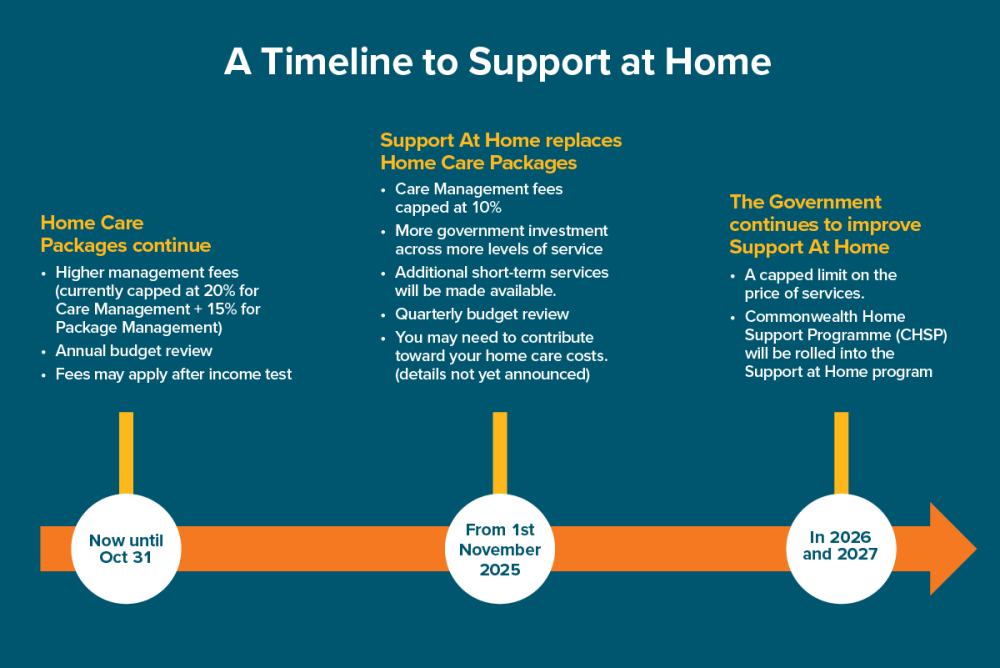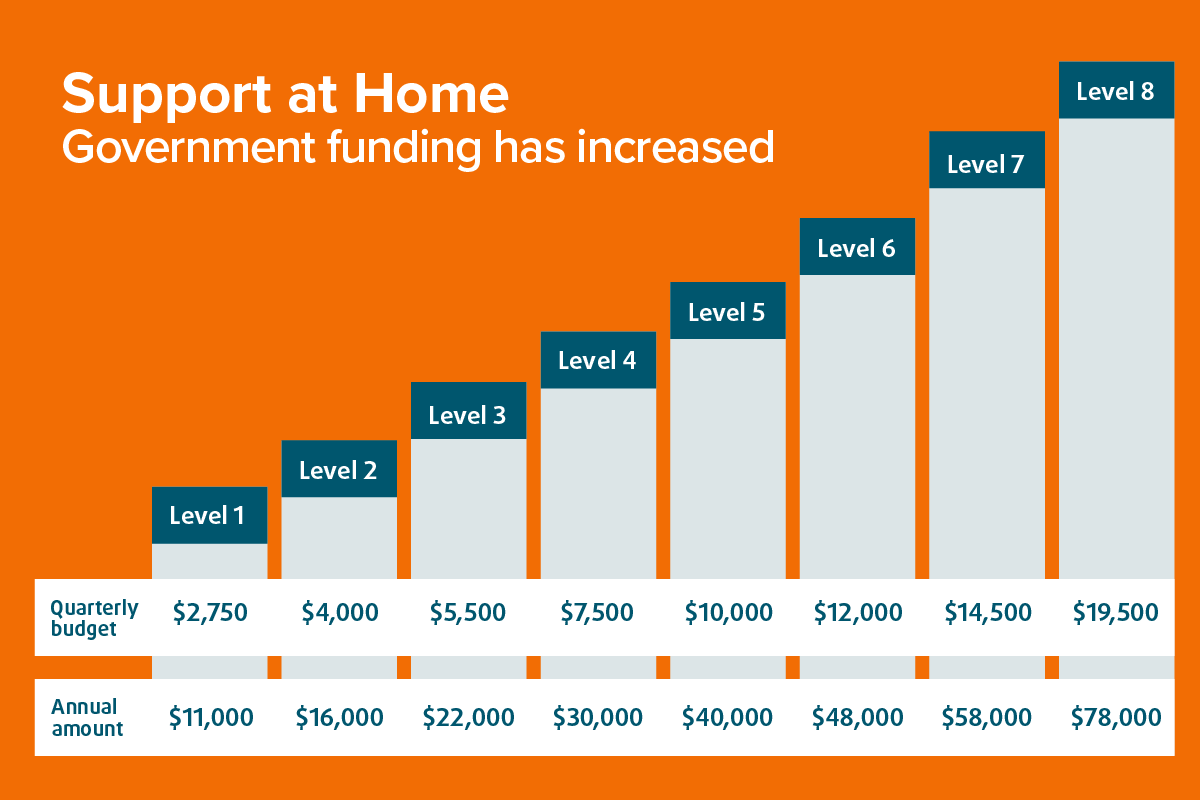
Share this article:
24 March 2025
Support at Home program: Things You Need to Know
The Australian Government is introducing the Support at Home program to replace Home Care Packages (HCP) and Short-Term Restorative Care from 1 November 2025. The Commonwealth Home Support Program (CHSP) will transition no earlier than 1 July 2027.
This new system aims to improve in-home care by reducing wait times, increasing access to services and ensuring funding is based on individual needs. However, there are some key changes, and potential drawbacks, that you as home care recipients should be aware of.
Summary of the Changes in Home Care Packages
- Eight levels of tailored support – More flexibility to match individual care needs.
- Shorter wait times – Faster access to services and interim funding while waiting.
- New assessment system – A streamlined process with automatic priority ratings.
- Three funding categories – Clinical care, independence support and everyday living
- Assistive technology and home modifications – Separate funding of up to $15,000
- New service options including end-of-life and short-term care

What Happens to Existing Home Care Package Recipients?
If you already have a Home Care Package, you will automatically transition to Support at Home on 1 November 2025. Your budget will match your existing HCP level and you won’t need reassessment unless your needs change. Australians on the National Priority System prior to 12 September 2024 will also receive equivalent funding under the new program.
What are the new Home Care Reforms?
1. New Eligibility and Assessment Process
Since 1 July 2024, in-home care eligibility has been determined by a Single Assessment System using the Integrated Assessment Tool (IAT). This has replaced the current fragmented assessment process and ensures funding is tailored to your needs.
Eligible groups include:
- Australians aged 65 and over
- Aboriginal and Torres Strait Islander people aged 50+
- Australians aged 50+ who are homeless or at risk of homelessness
2. Home Care Funding and Contribution Changes
The government will continue funding in-home care, but some cost-sharing changes will apply. Instead of set fees, contributions will be based on the type of service received and financial means.
| Type of Service | Government Funding | Client Contribution |
|---|---|---|
|
Clinical care Services under this category include clinical nursing care, physiotherapy, and other Allied Health services. Care Management also falls under this category. |
Fully funded | No cost to client |
|
Independence support Services under this category include personal care, social support, respite, and transport. |
Partial funding | Moderate contribution |
|
Everyday living Services under this category include domestic assistance including cleaning, meals, gardening, and home maintenance. |
Partial funding | Higher contribution |
Support at Home will introduce a fixed service list with capped prices to standardise costs. Providers cannot charge above these limits or add extra administration fees.
Full pensioners will pay between 5%–18% for non-clinical services with the new Support at Home classification. However, there’s a transition period that consumers should be aware of. We’ve summarised the co-contributions in the table below:
| Clinical Care | Independence | Everyday Living | ||||
|---|---|---|---|---|---|---|
| Before 12 September 2024 | After 12 September 2024 | Before 12 September 2024 | After 12 September 2024 | Before 12 September 2024 | After 12 September 2024 | |
| Full Pensioner | 0% | 0% | 0% | 5% | 0% | 18% |
| Part Pensioner | 0% | 0% | 0%-25% | 5%-50% | 0%-25% | 5%-50% |
|
Self-funded retiree (holding or eligible for a Commonwealth Seniors Health Card - CSHC) |
0% | 0% | 0%-25% | 5%-50% | 0%-25% | 5%-50% |
| Self-funded retiree | 0% | 0% | 25% | 50% | 25% | 80% |
- Unused funds will roll over each quarter, but only up to $1,000 or 10% of the quarterly budget.

Read more about Support at Home funding here
3. More Support Levels and Pathways
Support at Home introduces eight funding levels, compared to the four levels under HCP. The highest level offers up to $78,000 per year (compared to $61,400 under HCP).
Two short-term care pathways will also be available:
- Restorative Care (6–12 weeks) – Helps regain independence and delay higher care needs.
- End-of-Life Care (12 weeks) – Provides enhanced in-home support for terminally ill individuals wishing to die at home.
4. What is the Governments “No Worse Off” Promise
If you’re an existing Home Care Package recipient, you might be wondering how the changes impacts you.
According to the Government, if you were already receiving a Home Care Package, on the National Priority System or assessed as eligible for a package prior to 12 September 2024, you will be no worse off under Support at Home.
- Your financial contribution into the scheme will be the same or lower than under your Home Care Package.
- If you move into an aged care home at any time in the future you’ll be subject to the current residential aged care means testing arrangements, unless you opt into the new contribution arrangements. However, if you move into an aged care home after 1 November 2025, you will be subject to the new accommodation payment arrangements.
5. Assistive Technology and Home Modifications
A separate Assistive Technology and Home Modifications (AT-HM) Scheme will provide funding for equipment and home modifications, with three funding tiers:
| Tier | Funding Cap* |
|---|---|
| Low | $500 |
| Medium | $2,000 |
| High | $15,000 |
Some co-contributions may be required for higher-cost items.
Learn more about Assistive Technology and Home Modifications
*Time limits apply to these funds
6. Get to know the key terminology changes
|
Previously Home Care Package |
Now Support At Home |
|---|---|
| Funding Delivery – “Package” | Funding Delivery – “Classification” |
| Client Advisor | Care Partner |
| Clinical Case Manager | Senior Care Partner |
How Benetas Can Help You Navigate Home Care
The Support at Home program aims to make home care simpler, fairer and more effective for older Australians. It provides us with a once-in-a-generation opportunity to redesign the system and enable a better experience for Australians who choose to remain in their homes as they age. Whether you’re already receiving care or planning ahead, it is important to understand these changes to help you make informed decisions and the right choices for your unique circumstances.
At Benetas, we’re committed to guiding you through this transition no matter where you’re at in your journey.
If you’re an existing client, call your Care Partner (previously known as a Client Advisor) who will help you to understand the impact on your care plan.
If you’re a new customer, contact us for more information and tools to help you navigate government funding or shopping for a home care provider.
Frequently Asked Questions
If you wish to continue receiving in-home care under the government funded scheme, you must have a valid agreement in place. We are happy to answer any questions or concerns you have as we all navigate this new government program together.
We will contact you over the coming weeks to review your care plan and prepare a new service agreement. We will be able to provide more detailed information on the new program and prepare you for the transition to Support at Home from 1 July 2025.
We will endeavour to keep you informed throughout the stages of this change. However, you can also speak to a trusted family member or caregiver, or the Older Persons Advocacy Network (OPAN).